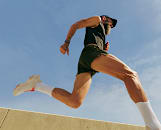
FreshSplash/E+ via Getty Images
Pilates vs. Barre: How to Choose the Best Low-Impact Workout for You
While they share similarities, these two modalities have key differences you'll want to consider.
By Alyssa Sparacino, Team Peloton•
What Is Barre?
Benefits of Barre
What Is Pilates?
Benefits of Pilates
Pilates vs. Barre: Key Similarities
Pilates vs. Barre: Differences to Know
How to Choose Between Pilates and Barre
Get Started with Peloton’s Pilates and Barre Classes
It can be tricky to find the right workout modality for your fitness goals and preferences. What’s better for your stamina—running or rowing? Should you do HIIT or a full body workout? And then there’s Pilates vs. barre. Both of these low-impact workouts bring unique benefits to your fitness routine. Here, we break down some key differences between barre and Pilates, plus their similarities, to help you determine what type of workout is right for you.
Discover more ways to reach your goals with Peloton
What Is Barre?
As you might expect, barre workouts have roots in formal ballet. But while there is a literal ballet barre in some studio classes (or an equivalent, like the back of a chair, for example, if you’re doing a Peloton barre class), you don’t need to be a classically trained ballerina to reap the benefits of this workout.
Barre routines are low-impact, yet high-energy. If you gravitate toward traditional weightlifting classes that focus on your major muscle groups, barre can help target your accessory muscles. These smaller (and often hard-to-reach) muscles are critical for building strength and stability.

Peloton App
Access thousands of classes with no equipment needed.
Benefits of Barre
The principles of barre help “create a well-rounded, low-impact workout designed to empower everybody,” says Tanya Becker, instructor and barre studio co-founder. Here are some of the biggest benefits you can expect from this workout.
1. It Builds Strength
Barre improves your overall strength through low-impact, high-rep exercises. While it’s a full body workout, it’s particularly helpful in targeting your lower body and abdominal muscles, Becker says.
2. It Improves Your Posture
Ballerinas are known for their grace, poise—and good posture. And while you may never become a professional dancer, barre workouts can help you build better posture and prevent slouching. “Barre emphasizes proper body alignment and engagement of core muscles, promoting good posture,” Becker says.
3. It Increases Your Flexibility and Mobility
Many barre classes combine strength moves with targeted stretches to maintain and improve your flexibility and range of motion, which can reduce the risk of injuries, Becker says. Building mobility is critical not just for your exercise routine—but also for regular everyday activities such as walking, sitting, and climbing stairs.
4. It Works on Your Cardiovascular and Muscular Endurance
Known for their fast-paced movements, barre workouts will elevate your heart rate, helping you build and maintain your endurance. Plus, the mix of high reps with light weights in these workouts increases your muscular endurance, adds Becker.
5. It Helps Reduce Stress
It’s no secret: Exercise releases feel-good endorphins, which can boost your mood. Due to their emphasis on specific movement patterns, barre workouts provide “an opportunity to focus on movement and breath, promoting relaxation and stress reduction,” Becker says.
6. It Strengthens Your Mind-Body Connection
Barre requires you to concentrate to remain present and maintain your balance. “Consistent practice can help you develop better body awareness, increase mobility, and enjoy more ease and grace during everyday activities,” Becker says.
What Is Pilates?
Like barre, Pilates is a low-impact workout that focuses on controlled movements and targets those smaller, stabilizer muscles. The method was created by Joseph Pilates in the 1920s as a rehabilitation movement practice. Today, the six key principles of the practice—breath, concentration, centering, control, precision, and flow—are still applicable, regardless of whether you’re on the mat or a reformer.
Benefits of Pilates
Pilates emphasizes strengthening your core, which helps improve your posture, body alignment, and overall strength, Becker says. And building muscle isn’t limited to young Pilates enthusiasts. A 2017 study published in Experimental Aging Research found that practicing Pilates for a month increased lower body strength in a group of elderly participants. Here are some of the other benefits of this low-impact workout.
1. It Helps You Connect to Your Body
“Pilates makes you tune in and connect to yourself on a deep internal level,” says Peloton Pilates and yoga instructor Anna Greenberg. “The focus on proper functional movement, breathing, pelvic floor health, and the way everything connects and works together can have a hugely positive impact on everything else you do.” As Anna explains, “it can be easy to do movements (or even go through the motions in life) from the outside in, just making shapes. Pilates helps to ensure you do everything with integrity from the inside out, fully embodying every exercise and experience.”
2. It Develops Deep Core Strength
“Pilates exercises focus on strengthening deep core muscles, [including] your back and the pelvic floor,” Becker says. “[This] improves postural alignment, reduces the risk of musculoskeletal imbalances, and increases body awareness and stability.”
3. It Helps Rehab and Prevent Injuries
The low-impact nature of Pilates exercises, coupled with the intense focus on alignment and balance, can help you recover from injuries as well as prevent them in the future, Becker adds.
4. It Helps You Maintain Strength
In addition to working those deep core muscles, Pilates also builds strength throughout the rest of your body, including your glutes. Plus, the resistance training movements in these classes can help you maintain the strength you’ve developed through other workouts.
5. It Reduces Stress
The method emphasizes mindful movement. “Pilates exercises require a deep mind-body connection as well as deep breathing, which can help calm a racing mind and relieve tension,” Becker says. A regular Pilates practice can also improve your mental clarity and potentially relieve burnout, she adds. A 2020 study published in Complementary Therapies in Medicine of 87 young men found that a 30-minute Pilates session reduced stress, lowered fatigue levels, and increased energy in participants.
Pilates vs. Barre: Key Similarities
There are a lot of parallels between these two practices. One of the biggest similarities is that both Pilates and barre are appropriate for all fitness levels, Becker says. Your instructor will be able to offer modifications throughout the workout to make certain exercises easier or more challenging. You can also adapt movements for any injuries or limitations you might have.
Barre and Pilates both focus on controlled, low-impact strength training, posture work, as well as mobility and flexibility, she says. If you’re an avid runner or cyclist, both of these modalities can act as a slow, calmer pairing to your more intense cardio workouts.
Plus, both barre and mat Pilates can be done without any equipment, making them ideal workouts to do while traveling or when you have limited space.
Pilates vs. Barre: Differences to Know
However, despite all the similarities between the two, Pilates and barre are still distinct modalities. One of the most notable differences between them is in their equipment or tools. If you’re taking a Pilates reformer class, you’ll use a reformer with springs and straps for the majority of your exercises. Mat Pilates, on the other hand, can be done without equipment, or with some small Pilates props. Barre classes will often utilize light weights, a small exercise ball, and resistance bands.
“Barre targets individual muscles with a more isolated approach, while Pilates targets multiple muscle groups working together and often has more of a continuous flow to its format,” says Anna.
While both methods can push the pace, barre tends to up the cardiovascular challenge more so than Pilates, Becker says. “Barre classes combine isometric exercises with bigger more dynamic movements that include intervals to elevate the heart rate,” she says.
Additionally, barre classes tend to follow the beat of the music and emphasize having a tucked pelvis, Kristin McGee previously told The Output. In comparison, in Pilates, you typically focus on maintaining a neutral pelvis.
How to Choose Between Pilates and Barre
If you’re ready to hit play on your next workout and can’t decide between Pilates or barre, consider your fitness goals and preferences, Becker says.
If you’re looking for a low-impact, active recovery workout, the slower pace and core-focused aspect of Pilates may appeal to you. “Pilates classes have a seamless flow of continuous movement,” explains Anna. “It is also an excellent core workout, always!”
Conversely, if you’re seeking a cardiovascular challenge coupled with holds and pulses to strengthen your muscles, turn to a barre class.
Still torn? Integrate both into your routine. “Both modalities are excellent for creating internal stability and the ability to move with greater ease and fluidity in everything you do,” says Anna. “They work beautifully together to create a strong & graceful foundation for movement of all kinds.”
Take a few classes with different instructors and see what you enjoy. Chances are you’ll find elements of each you love. Regardless of which option you choose, you can’t go wrong with making both Pilates and barre a part of your regular workout regimen.
Get Started with Peloton’s Pilates and Barre Classes
Peloton’s barre and Pilates workouts have something for everyone, regardless of whether you have 15 minutes to spare or want something similar to what you might find at your local studio. There are also classes geared more towards Pilates for beginners or barre for beginners.
Whether you want to try a barre or Pilates class, here’s how to decode Peloton’s classes:
10 min classes: These classes are ideal for stacking together to build your perfect workout. They hone in on specific muscle regions, so you can take two or three together for a full body workout, even mixing between the two modalities.
15 min Express classes: When you’re short on time but want a full workout, these classes are your secret for getting it all in on a busy day.
20 min music and theme classes: Our signature class format, these classes are slower-paced and great for beginners, while still providing a comprehensive workout. Look for your favorite music genres, like Rock and Hip Hop.
30 min Barre: Sculpt & Pilates: Power: If you’re comfortable with barre and Pilates and want a faster-paced challenge, these pack a punch in just 30 minutes with less time for rest. Some classes may feature equipment to add resistance.
45 min Barre: Get the full in-studio class experience from anywhere with our most comprehensive class offering. Barre classes include additional time spent on lengthening movements, while Pilates classes features a classical, slowed-down approach to go deep in every movement.
This content is for informational and educational purposes only and does not constitute individualized advice. It is not intended to replace professional medical evaluation, diagnosis, or treatment. Seek the advice of your physician for questions you may have regarding your health or a medical condition. If you are having a medical emergency, call your physician or 911 immediately.
Build full-body strength
Enter your email to get articles, instructor tips, and updates from Peloton sent to your inbox.
By providing your email address, you agree to receive marketing communications from Peloton.
For more about how we use your information, see our Privacy Policy.










